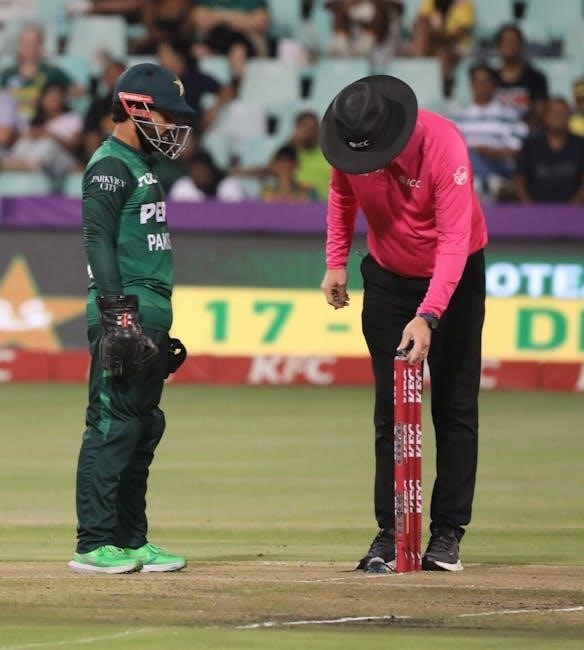Choosing the right cricket bat size is crucial for performance and comfort. This guide covers bat sizes based on age, height, and weight, ensuring optimal fit for players of all levels.
Key Factors Influencing Cricket Bat Size
Age, height, and weight are the primary factors influencing cricket bat size, ensuring optimal performance, comfort, and proper fit for players of all levels.
Age and Height Correlation
Age and height are key factors in determining the appropriate cricket bat size. Younger players, typically aged 4-5, require smaller bats (size 1), while older players (11-13) use larger sizes (size 6). Height ranges correspond to these age groups, ensuring proper fit and technique. For instance, a child aged 8-9 (size 4) should be 4’3″-4’6″ tall. This correlation ensures the bat is proportionate to the player’s physical stature, promoting comfort and effective play. While individual variations exist, this guide provides a reliable starting point for selecting the right bat size based on age and height.
Weight Considerations
Cricket bat weight plays a significant role in performance and comfort. Junior bats typically weigh between 1lb 13oz and 2lb 5oz, while adult bats range from 2lb 8oz to 3lb 2oz. Lighter bats are ideal for younger players, enhancing control and maneuverability, while heavier bats suit stronger, more experienced players. Weight preferences also vary based on playing style; aggressive players may prefer lighter bats for faster swings, while power hitters might opt for heavier ones for maximum impact. Proper weight distribution ensures optimal balance, reducing fatigue during long innings. Always consider the player’s strength and skill level when selecting bat weight to maximize comfort and performance.
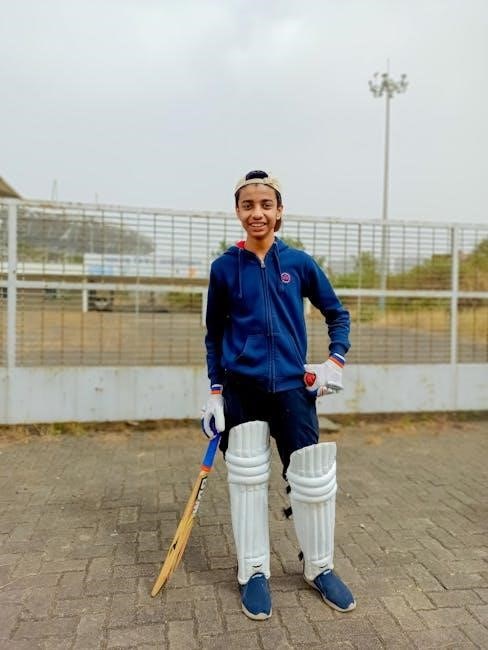
Cricket Bat Size Chart Based on Age
Cricket bat sizes range from 1 to 6 for juniors, with Harrow and Short Handle options for older players. Age correlates directly with bat size, ensuring proper fit and performance.
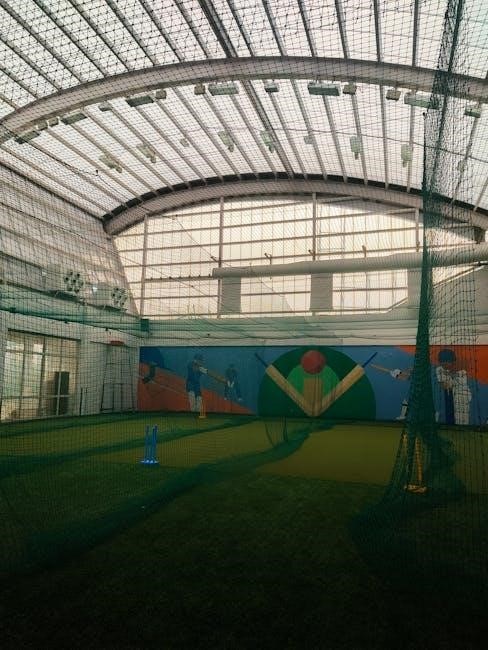
Junior Bat Sizes (Ages 4-14)
Junior cricket bats are designed for players aged 4 to 14, with sizes ranging from 3 to 6. Bat size 3 suits 4-5 year olds, size 4 for 6-7 year olds, size 5 for 8-9 year olds, and size 6 for 10-14 year olds. The weight of junior bats typically ranges from 1lb 13oz to 2lb 5oz, ensuring lighter options for younger players. Height plays a significant role, with size 3 bats for children under 4ft 3in, size 4 for 4ft 3in-4ft 6in, size 5 for 4ft 6in-4ft 9in, and size 6 for 4ft 9in and above. Proper sizing ensures comfort, control, and optimal performance for young cricketers.
Harrow and Short Handle Sizes
Harrow and Short Handle (SH) bats cater to specific age groups and player heights. Harrow bats are ideal for players aged 15 or those between 5’2″ and 5’8″ in height, offering a slightly larger blade than junior sizes. Short Handle bats are designed for adults, typically suited for players between 5’7″ and 6’2″ in height. SH bats are lightweight, ranging from 2lb 7oz to 3lb 2oz, making them easy to maneuver. They provide a balance between power and control, making them popular among adult players. Proper sizing ensures comfort and performance, with Harrow bats bridging the gap between junior and adult sizes, while SH bats are tailored for adult players seeking optimalbatting efficiency.
Cricket Bat Size Chart Based on Height
Cricket bat size is tailored to player height for optimal performance. Adults typically use Short Handle bats, while smaller sizes suit younger players based on height ranges.
Bat Size Recommendations for Adults
Adult cricket bats are primarily available in two sizes: Short Handle (SH) and Long Handle (LH). SH bats are the most common choice, suitable for players between 5’7″ and 6’2″ (170cm to 188cm), offering ease of handling and maneuverability. LH bats are designed for taller players, typically those over 6’2″ (188cm), providing extra reach and leverage. Bat lengths for adults range from 33.5 to 34.5 inches, with weights between 2lb 7oz and 2lb 13oz. Taller players often prefer LH bats for better control, while shorter players find SH bats more manageable. Weight distribution is crucial, ensuring the bat feels balanced for optimal performance.
Small Adult and Academy Sizes
Small Adult and Academy bat sizes are designed for players transitioning from junior to full-size bats. These bats are ideal for taller juniors or smaller adults, typically aged 14-15 years or 5’2″-5’8″ (157cm-172cm). Academy bats are slightly shorter and lighter, making them easier to handle while maintaining performance. Small Adult bats, often labeled as Harrow or size 5, are perfect for players who need a bat between junior and full size. They offer better control and technique development. The weight range for these bats is 2lb 7oz to 2lb 11oz, with handle sizes slightly smaller than full-size bats, ensuring a comfortable grip and swing.
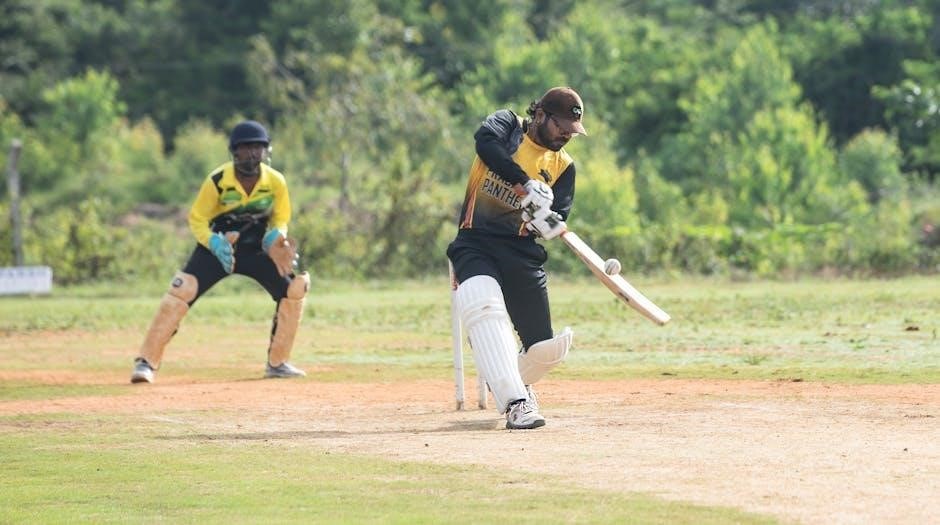
Cricket Bat Weight Guide
Cricket bat weight is crucial for performance, typically ranging from 1lb 13oz to 2lb 11oz. Lighter bats offer better control, while heavier bats provide more power and durability.
Junior Bat Weights
Junior cricket bats are designed to be lightweight, ensuring young players can manipulate the bat with ease. Sizes range from 3 to 6, with weights starting at approximately 1lb 13oz for a size 3 bat and increasing gradually. A size 4 bat typically weighs between 2lb 1oz and 2lb 3oz, while a size 5 bat ranges from 2lb 2oz to 2lb 4oz. The size 6 bat, suitable for older juniors, weighs around 2lb 3oz to 2lb 5oz. These weights ensure a balance between control and power, allowing young cricketers to develop their skills comfortably. The weight distribution also considers the player’s age and height, ensuring optimal performance and comfort during play.
Adult Bat Weights
Adult cricket bats typically weigh between 2lb 7oz and 3lb, with the ideal weight depending on player preference, strength, and batting style. Lighter bats (around 2lb 7oz to 2lb 9oz) are favored by players who prioritize quick reflexes and precise control. Heavier bats (2lb 10oz to 3lb) are preferred by power hitters seeking maximum impact. The weight also varies based on the type of willow used, with higher-grade willow bats generally being lighter. Handle size and material further influence the overall weight distribution. Ensuring a balance between weight and performance is key for adult players to optimize their batting experience and comfort during the game.
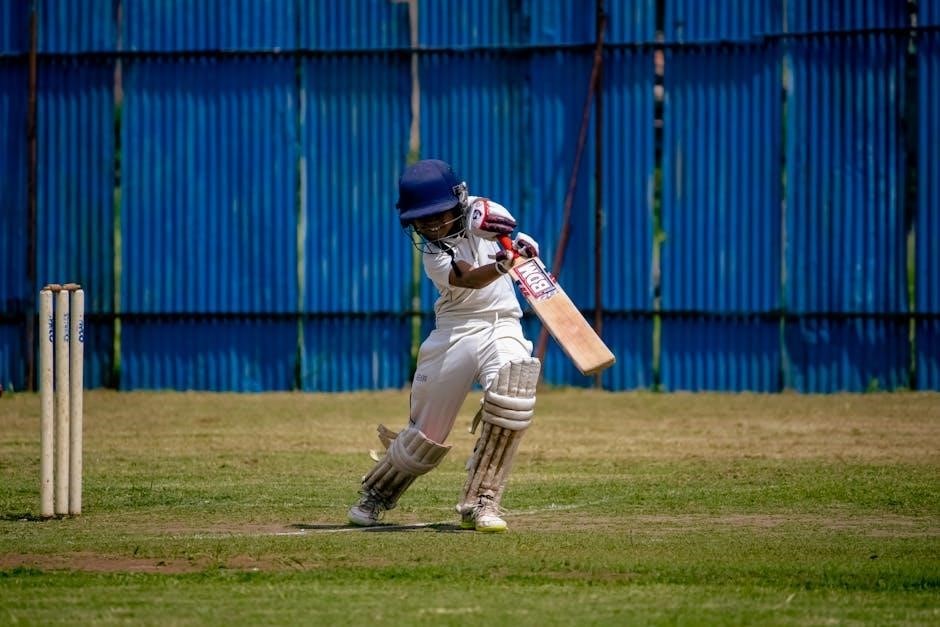
Cricket Bat Handle Size Guide
Cricket bat handles vary in size, affecting control and power. Short handles suit taller players, while longer handles offer better grip for younger or shorter batters.
Short Handle (SH) vs. Long Handle (LH)
Cricket bat handles come in two primary sizes: Short Handle (SH) and Long Handle (LH). SH bats are the most common choice, suitable for players between 5’7″ and 6’2″ (170cm to 188cm), offering better control and power. LH bats, while less popular, cater to taller players (above 6’2″) and provide additional reach. Handle size significantly impacts grip and stroke play, with SH preferred for its balanced weight distribution. Proper fit ensures optimal performance and comfort, making handle size a critical factor in bat selection.
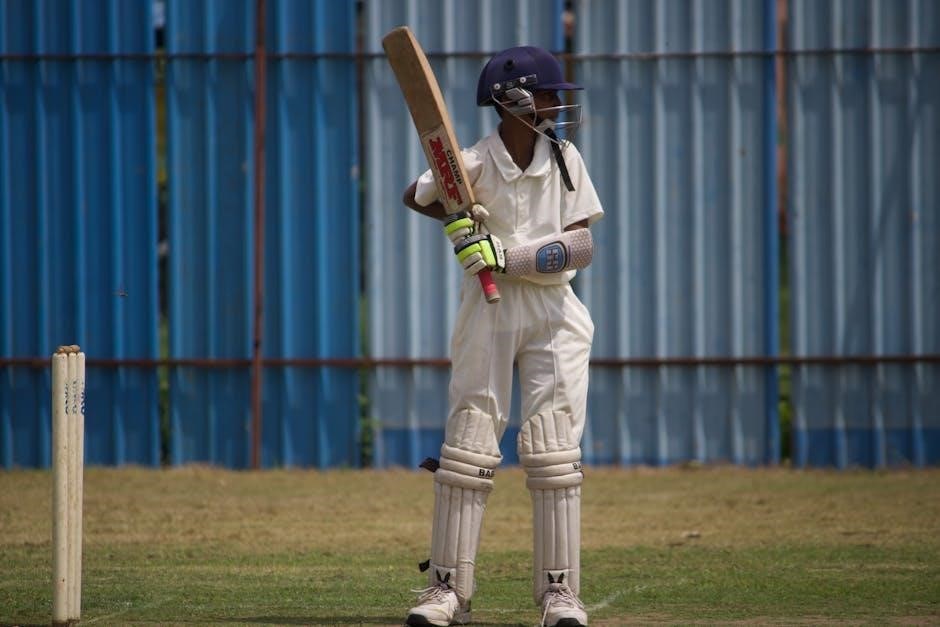
- SH: Ideal for most adult players, enhancing control and power.
- LH: Suitable for taller players, offering extended reach but requiring more strength to manage.
Choosing the right handle size ensures a better batting experience.
Handle Size and Player Height
Handle size is directly correlated with player height to ensure optimal performance and comfort. Short Handle (SH) bats are ideal for players between 5’7″ and 6’2″ (170cm to 188cm), providing better control and power due to balanced weight distribution. Long Handle (LH) bats cater to taller players above 6’2″, offering additional reach but requiring more strength to manage effectively. Proper fit is crucial for effective stroke play and comfort, significantly enhancing the batting experience. Players should consider both handle length and their height when selecting a bat, possibly consulting a size chart or expert for the best fit. This ensures a balance between performance and comfort, tailored to individual needs.
- SH bats: Suitable for players between 5’7″ and 6’2″.
- LH bats: Designed for players taller than 6’2″.
Frequently Asked Questions (FAQs)
Common questions include age vs. bat size, weight considerations, and handle types. Key factors like height and weight are also addressed, along with manufacturer-specific guidelines.
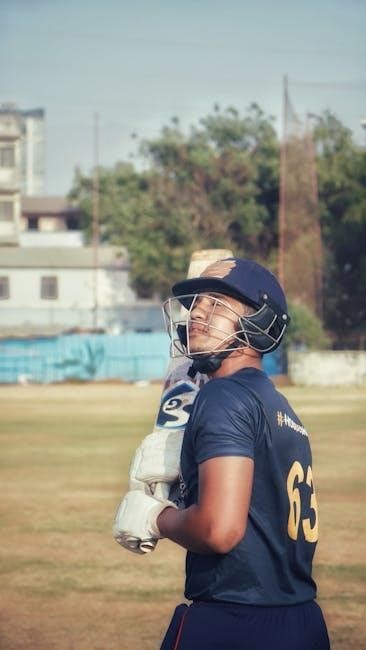
- What age should use size 4 cricket bats?
- What age should use size 6 cricket bats?
What Age Should Use Size 4 Cricket Bats?
Size 4 cricket bats are typically recommended for children aged 9-10 years old. This size is designed to suit young players who are growing into the sport and need a bat that matches their physical development. The bat’s dimensions, including its length and weight, are tailored to provide comfort and control for this age group. While age is a key factor, height and personal preference can also influence the choice. Ensuring the bat feels balanced and easy to handle is crucial for improving technique and enjoyment of the game. Always consider consulting a size guide or seeking advice from a specialist to ensure the best fit.
What Age Should Use Size 6 Cricket Bats?
Size 6 cricket bats are generally suitable for children aged 11-13 years old. This size is ideal for young cricketers who are transitioning towards more advanced levels of play. The bat’s dimensions are designed to accommodate growing strength and skill, offering a balance between power and control. While age is a primary factor, height and personal comfort should also be considered. Players in this age range typically have more developed techniques, making the size 6 bat a practical choice for both training and competitive matches. Ensuring the bat fits well is essential for optimal performance and enjoyment of the game.
